Thinking about adding a Rottweiler to your pack?
Rotties are certainly awesome dogs — you don’t have to tell me, I own one!
But it is always important to learn as much as you can about any breed you’re thinking about buying or adopting. And this is especially true when you’re considering a breed as big, strong, and protective as the Rottweiler is.
We’ll try to help by explaining everything you need to know about these black-and-tan four-footers below. Just be sure to consider all of this info carefully before making your final decision.
Rottweiler Breed Profile: Key Takeaways
- Rottweilers are very smart, loving, and affectionate dogs, who make excellent pets for the right people and situations. This generally means families with a significant amount of canine experience, plenty of time to devote to the Rottie’s care, and a desire for a dog that’ll truly become a member of the family.
- Rottweilers were originally developed to be working dogs, but now they’re primarily kept as companion animals. Your new Rottie will love snuggling on the couch or accompanying you on errands, but she’ll also need a “job” to help prevent boredom, frustration, and depression.
- Rottweilers are amazingly loving and affectionate with their families, but they are often aloof around strangers. As long as you treat your Rottie with love, respect, and firm but fair guidance, she’ll love you more than you can imagine. But she probably won’t make new friends as easily as some other dogs do.
Rottweiler Info 101: The Breed Basics
Let’s start by just running down some of the basic facts about Rottweilers — we’ll get into deeper detail a bit later.
- Breed: Rottweiler
- Other Names: Rottie, butcher’s dog
- Coat: Short to medium-length
- Color Pattern: Rotties always feature their characteristic black and brown pattern
- Weight: 85 to 125 pounds (males are much larger than females)
- Height: 22 to 27 inches (males are much larger than females)
- Intelligence Level: Very smart dogs; typically ranked #9 among all breeds
- Shedding Level: Moderate; heavy during seasonal coat blows
- Grooming Requirements: Minimal; regular bathing and nail trimming
- Energy Level: Moderately high
- Trainability: Headstrong, but they learn quickly and love pleasing their people
- Clinginess: High to off-the-charts; Rotties become true family members
- Breed Popularity: Ranked #8 in the U.S. by the AKC
- Origin: Around the town of Rottweil, Germany
- Breed Registries: Recognized by most, including the AKC, UKC, and FCI
- Lifespan: 8 to 10 years
- Suitability for First-Time Owners: Categorically inappropriate for novices
The Rottweiler’s History

Rottweilers are generally recognized as one of the oldest dog breeds, and their history is a bit better known than some others. That said, the breed is so old that there are still a few gaps in our knowledge.
What we do know is that Rottweilers originally descended from a now-extinct Roman dog breed known as the Molossus.
These dogs were tasked with driving cattle, and Romans traveled alongside them as they marched on Germany, around 2,000 years ago.
Eventually, some of these dogs ended up in the city of Rottweil, where they interbred with the native dogs of the region.
Over time, their owners began using them for a variety of purposes, including protection. Butchers would reportedly have Rotties accompany them while working (hence the “butcher’s dog” moniker).

Some even claim that the butchers would hang their coin purses around the necks of their formidable dogs for safekeeping.
The dogs’ popularity declined as cattle driving stopped being a thing, and the breed nearly disappeared by the late 19th century. However, during the lead-up to World War I, police forces needed canines to work alongside their officers. Rottweilers were a natural fit, so their population began to recover.
A few Rottweiler clubs formed around the same time, including the Allgemeiner Deutscher Rottweiler Klub (likely the most important of the early clubs) in 1921. A few years later, the first Rottweiler was registered with the AKC. From here, their numbers only continued to grow, eventually peaking in the 1990s.

Getting Real about Rottweilers: The Good and the Bad
All of these facts, figures, and tidbits are great, but let’s talk about what it means to really share your life with a Rottweiler.
Let’s start by examining some of the benefits and challenges these puppers present for those who may be considering adding a little butcher’s dog to the fam.
First, the good:
- Rotties are unquestionably one of the most loving breeds you’ll ever encounter. They love their people in a way that’ll melt your heart on a daily basis and make it so that you never feel alone again.
- Rotties are crazy smart and quickly learn the basics of day-to-day life. I am pretty sure my own Rottie was housetrained in about 15 minutes (obviously an exaggeration, but you take my point). And it only took a trip or two to the park for her to learn how to help me clip on her leash, jump in the car, and then wait for me to get everything situated before jumping out to go exploring the park.
- Rotties are super-protective animals, which some owners love. While socialized, trained, and happy Rotties are great canine citizens, they’re almost always fiercely protective of their people and home.
- Rotties are mediators who require domestic harmony. Many Rottie owners have seen their pooch gently intervene during domestic discontent (even when it’s playful in nature). They’ll often place themselves right between quarreling family members or gently drag one of the two-footers away.
- Rotties are pretty easy to groom. Aside from regular tooth brushing, baths, and nail trims (check out the video below to see me grinding my Rottie’s nails), Rotties don’t need a whole lot of grooming.
- Rotties are potentially the most attractive dogs on the planet. OK, so I’m obviously biased and this is a subjective assessment. But you’ll be amazed at the number of strangers who’ll stop you at the park just to tell you how good looking your Rottie is. This is just one of the reasons why you should never own a Rottweiler, since it takes forever to get out of the park (spoiler alert: we kid).
See? There are tons of things to love about these little floofs. But like I said, they are clearly not right for all owners or situations, and they present some very serious challenges.
A few of the most notable include:
- Rotties are a whole lotta dog. Though I love ‘em, you have to understand that Rottweilers will have an enormous impact on your life. They aren’t 40-pound Lab mixes who daintily prance around the house. These are powerful, massive dogs, and you’ll never forget that for a second.
- Rotties are aloof dogs, who don’t always make friends easily. I mentioned this earlier, but it’s important to restate. Rottweilers aren’t like pit bulls or huskies who want to run around the dog park making friends with everyone. Introductions may take a bit of time. However, once you’ve befriended a Rottie, you have a friend for life.
- Rotties are high-maintenance dogs in many ways. The phrase “high maintenance” can mean a number of different things. In this case, I do not mean that they require elaborate grooming, nor do they need to go on a 5-mile run every morning the way an Aussie, podengo, or some other high-energy breed may. But Rottweilers do require a moderate amount of exercise and they need tons of mental stimulation.
- Rotties are susceptible to a number of expensive health issues. All breeds are susceptible to an assortment of health ailments, but some are more expensive and challenging to treat than others. In the case of Rotties, they often suffer from joint issues, such as hip or elbow dysplasia and osteoarthritis. None of these things are especially cheap to treat for any dog, but when you’re talking about a dog in the 100-pound-or-more ballpark, it’s easy to see why you may end up spending a ton of money at the vet.
- They’re kinda messy. Rottweilers don’t drool as much as mastiffs or Great Danes, nor do they shed as much as German shepherds. But they do both in not-inconsequential quantities. They also have a tendency to produce a metric butt ton of eye boogers.
- Rotties are often intimidating to people. For a variety of reasons, many people fear Rottweilers. And while this is a good thing where criminals and uninvited solicitors are concerned, it’s a bit of a bummer when it comes to random people at the dog park, who quickly move to the other side of the trail when they see you and your pooch approaching. So, if you do decide to own a Rottweiler, be sure that you do everything you can to make her a good ambassador for the breed.
- Rotties are included on just about every banned breed list in existence. Breed-specific legislation and housing policies are misguided, and they do not work. Don’t take my word for it: The American Veterinary Medical Association concurs. But in the real world, these lists exist, and Rotties invariably appear right after pit bulls. So, finding housing (and insurance, in some cases) can be challenging for owners.
Unfortunately, there’s one other heart-breaking downside to Rotties (and it’s difficult for me to even type this): They don’t live very long.
Their typical lifespan is between 8 and 10 years, and perhaps a little longer in exceptional cases. This, I’ve concluded, is nothing more than a cruel trick the universe has decided to play on Rotties and their people, but it’s one that you must know when diving into the black-and-tan waters.
Common Traits Aside, All Rotties Are Individuals
The traits discussed above are all pretty consistent, and they accurately characterize most Rottweilers. But it’s important to understand that all Rotties (indeed, all members of all breeds) are individuals, who exhibit various quirks and idiosyncrasies.
For example, most Rottweilers are sensitive (as are guarding breeds in general – it’s part of what made them so well suited to the roles they played early in their development).
But my pooch is exceptionally sensitive.
In many ways, this is a good thing. If I’m feeling a bit bummed out, she knows and is likely already licking me and looking up at me with those oxytocin-inducing eyes. When I’m happy to see her (which is always), she gets even happier than I am. And when I’m excited about something and ready to celebrate, she’s always down to party with me.
But it can also be difficult.
Let’s say I’m frustrated about something. She will pick up on this, and it will take a toll on her – no matter how much I try to reassure her.
And despite being a gigantic beast of a dog, she’s easily spooked by loud noises in the kitchen.
This dog will immediately put herself between me and what she perceives as a threat without a second thought, but if I accidentally bang a pan or make too much noise when changing the garbage bag? Forget about it – she’ll be hiding somewhere safe.
The point of all this is that while we can talk about breed tendencies, at the end of the day, all dogs are unique individuals. And you won’t know what your pup’s quirks are until you’ve already brought her home.
Bottom Line: Is a Rottweiler the Right Dog for Your Family?
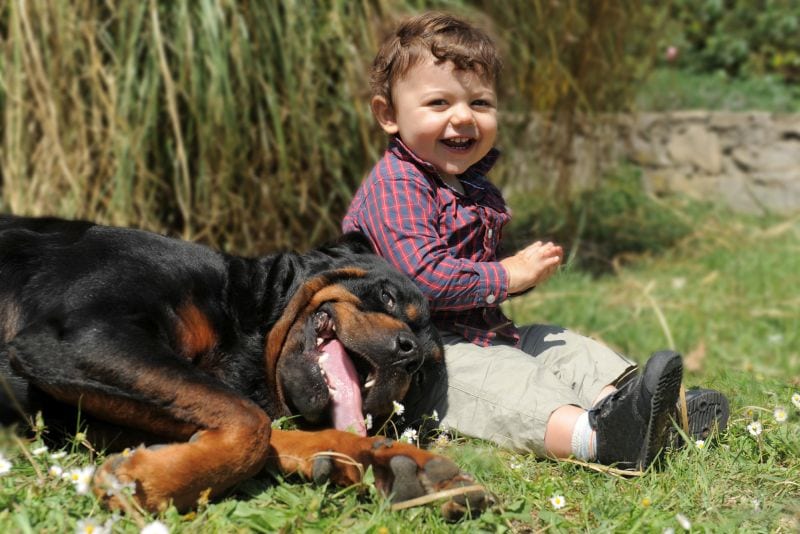
Before you go out and buy or adopt a cute little black-and-tan puppy, just make sure that the following sounds like a fair characterization of your family:
- You have a lot of experience caring for dogs. We mentioned this earlier, but this is just a terrible breed for first-time owners. If you’ve never had a dog, consider a Lab, greyhound, or one of the others mentioned in our guide to good breeds for first-time owners.
- You’re willing to devote the time and resources necessary to train your Rottie properly. Because Rottweilers are really big, really protective, and somewhat suspicious of strangers, they must be socialized and trained properly. And if you run into issues, you’re going to need to pay for professional help.
- You have the space necessary for such a big breed. Rotties don’t need to run for miles every day, but they do need a roomy home and, ideally, a fenced backyard. Also, keep in mind that your Rottie’s bed, crate, and other items are going to take up a lot of space too.
- You don’t have significant dog allergies. Rotties may not shed as much as GSDs or some other breeds, but they do produce quite a bit of drool (and that’s often what actually triggers allergies in humans anyway — the drool sticks to the shed fur). If you have minor allergies, you may be able to tough it out, but these are certainly not “hypoallergenic” dogs.
- You have the financial resources to provide appropriate veterinary care. As mentioned, Rotties often suffer from significant and expensive to treat health problems. Even normal veterinary procedures will cost more for a Rottie than they would a smaller dog breed, so be sure you can afford to provide the care your new dog deserves.
- You aren’t away from the house for long periods of time. Rottweilers really bond strongly with their people, and they don’t like being left alone for long periods of time. Simply put: If you’re at work or school for 8 or more hours a day, look for a different, lower-maintenance breed.
- You can afford to feed a large-breed dog. Rottweilers are prone to weight gain, so it’s important that you don’t overfeed your pooch. That said, providing enough calories for a 100-pound dog isn’t exactly cheap.
- You really want a dog who’ll essentially become another family member. If you’re not 100% convinced that you want a dog who’ll not only be a pet but a bona fide member of the family, then look for another breed. Rotties are sensitive, loving, loyal, and affectionate dogs who need to be with their people. We don’t think many dogs (some of the livestock guarding breeds aside) should just be left in the backyard all the time, but Rotties are absolutely, positively incompatible with this lifestyle.
***
We hope this profile has helped you understand Rottweilers better and determine whether one would be a good fit for your family. I’m obviously a big fan of these doggos, but they certainly aren’t a good fit for all people and situations.
As one last bit of parting advice, I’d encourage prospective Rottie parents to meet several examples of the breed to see what they’re really like in person.
Do you have a Rottweiler of your own? Let’s hear about her! Tell us what I forgot to mention, as well as anything else you think people considering the breed should know.







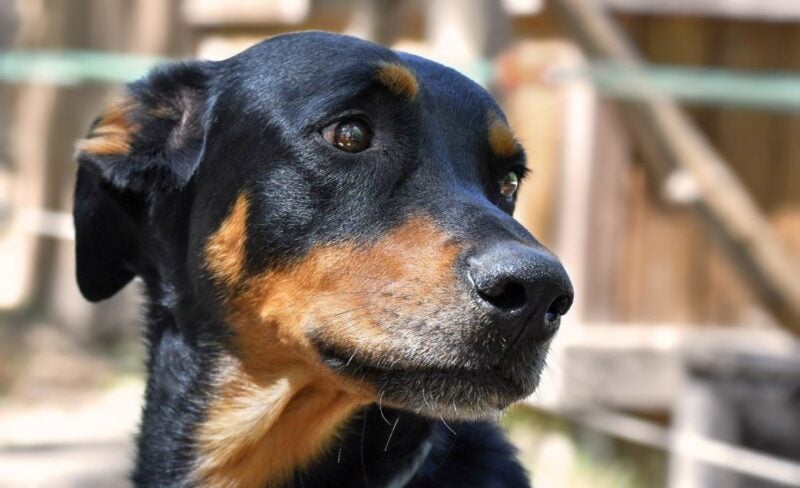

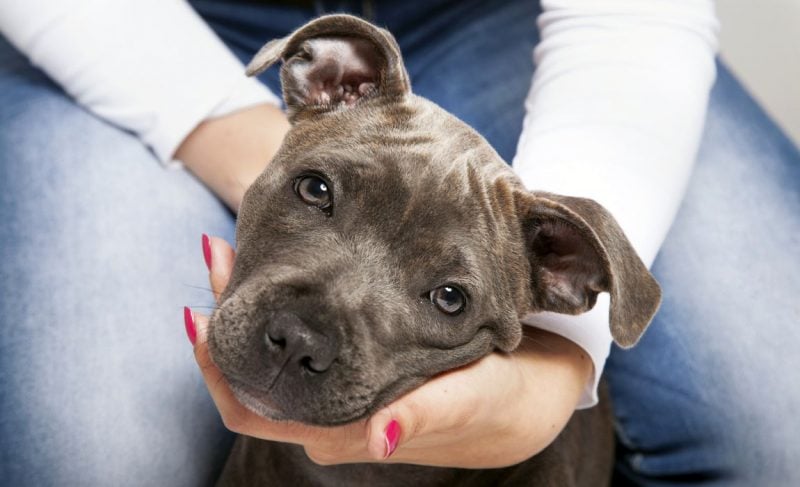
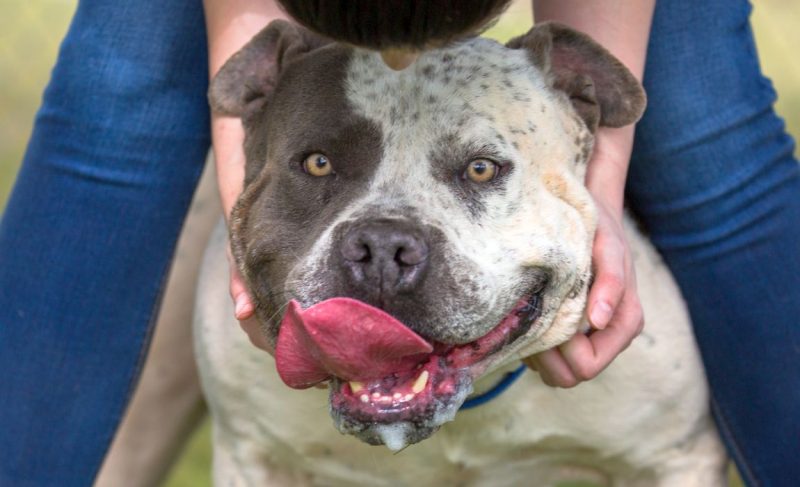
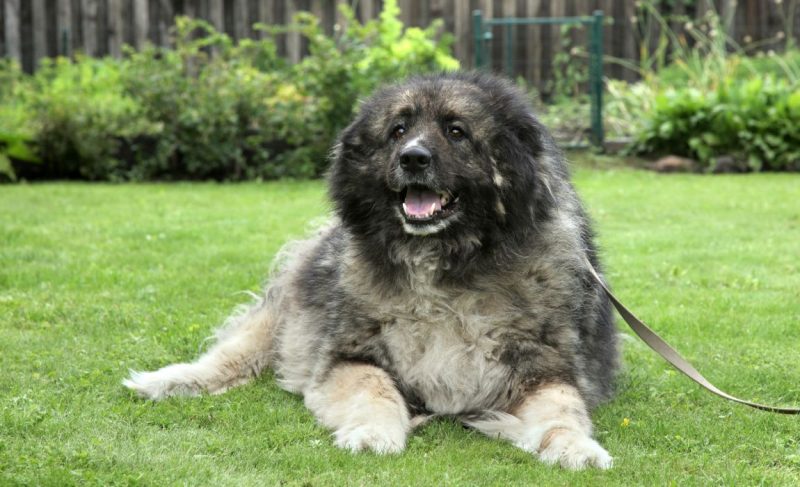

Leave a Comment